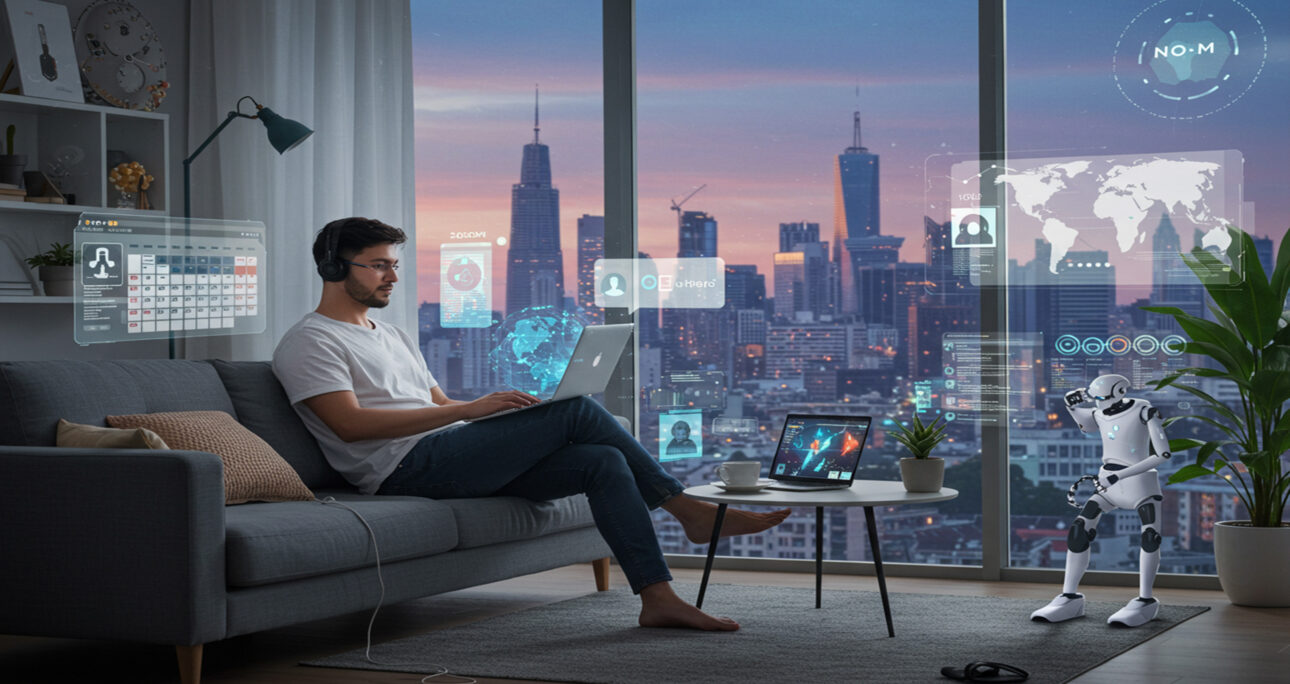In 2019, “remote work” sounded like a perk. In 2020, it became a necessity. By 2025? It’s the era of Digital Nomad 2.0—an ecosystem we’re only beginning to explore.
We’re entering the age of Digital Nomad 2.0—and no, it’s not about sipping cocktails on beaches with a laptop (though that still happens). It’s about async work, AI assistants, decentralized teams, and a growing class of people who don’t just work remotely—they live differently.
Let’s break it all down.
What’s Changed Since “WFH”?
Let’s be real—work from home started as a workaround. Back in the early 2020s, people were still trying to replicate office vibes with Zoom fatigue, back-to-back calls, and the occasional “You’re on mute.”
That’s version 1.0.
Now? We’ve moved past mimicking the office and started designing a new way of working. People are less interested in pretending they’re at their desk from 9 to 5. Instead, they care about outcomes, freedom, and flow.
Trend 1: Async Is the New Default
Imagine never needing to wait for a meeting to move forward.
That’s asynchronous collaboration. And it’s becoming the norm.
- Instead of meetings, people record Loom videos.
- Instead of real-time chats, they use detailed Notion pages, voice notes, and shared dashboards.
- Everyone contributes when it makes sense for them—no matter the timezone.
It’s more peaceful. No more 2 AM calls because your team’s in three countries. No more awkward pauses in meetings with unstable internet.
Async work lets you own your time. You can go for a walk, pick up your kid, or take a break—without feeling like you’re slacking.
Trend 2: Your New Coworker Is AI
Remote workers aren’t just collaborating with people anymore—they’re working side-by-side with AI.
And we’re not talking about clunky chatbots.
We’re talking real assistants that help you write emails, manage tasks, summarize meetings, even prep your calendar based on how your brain works.
This isn’t replacing jobs. It’s reducing busywork. The modern remote worker isn’t grinding. They’re delegating—to AI. Which leaves more time for… actual thinking.
Trend 3: The Rise of the Borderless Professional
Passports are still required, but geography barely matters now.
In 2025, it’s completely normal to:
- Have a tax accountant in Estonia
- A project manager in Kenya
- A designer in Vietnam
- And a business partner in Buenos Aires
All working together, with different passports and bank accounts, but one shared vision.
This “borderless” model works because global payroll platforms (like Remote, Deel, and Oyster) handle the legal mess. Crypto payments and stablecoins make it faster to pay/receive globally. Time independence lets people work at their best hours, not yours. Companies aren’t asking “Where are you based?” anymore. They’re asking “Can you deliver?”
So What’s Different About Digital Nomad 2.0?
Let’s throw out the clichés. This isn’t about working in Bali with a laptop and a smoothie.
Digital Nomad 2.0 is:
- Purposeful, not performative
- Calm, not chaotic
- Structured, yet flexible
They don’t just travel for vibes. They move with systems. They’ve got:
- A personal productivity stack
- Async systems for clients or teams
- Passive income or micro-consulting gigs
- Travel routines (work during weekdays, explore on weekends)
And yes, noise-cancelling headphones are still a must. They’re not escaping something. They’re designing something better.
A Day in the Life (2025 Edition)
Wake up in Lisbon. No alarm. Open Slack—nothing urgent. You reply to some Looms from a US client. Then review AI-generated drafts your assistant pulled together overnight.
You’re not rushing. You’re editing, guiding, curating.
Later, you take a midday hike. When you come back? Your calendar has shifted your next task to tomorrow because your AI noticed you’re behind on sleep and blocked off your afternoon.
It’s not sci-fi. This is already happening.
Challenges Still Exist
Let’s not sugarcoat it. This lifestyle isn’t perfect.
- Isolation: No commute means fewer human interactions. And async work—while efficient—can sometimes feel…cold.
- Work Creep: Without clear office hours, work can bleed into your life.
- Legal & Tax Stuff: Living in Thailand while working for a Canadian company and getting paid in crypto? That’s a legal puzzle.
Remote work platforms are solving it, slowly. But you still need a good accountant.
New Workspaces, New Habits
You’ve heard of co-working. 2025 introduces:
- Co-living spaces for remote teams: Think WeWork meets Airbnb
- Workations: Packaged trips with productivity schedules and team bonding
- Deep work retreats: No distractions, no noise—just focused time to build or create
People aren’t just chasing Wi-Fi anymore. They’re seeking environments that support creative energy, healthy routines, and focused work.
The Solo Brand Operator
Another trend? Solo creators who run lean, profitable businesses powered by remote tools. They’re designers, writers, strategists, engineers… using platforms like:
- Gumroad to sell digital products
- Circle for community
- Fiverr Pro or Contra for client gigs
- Ghost or Beehiiv for newsletters
These aren’t influencers. They’re operators. They work from anywhere. But they also build from anywhere.
Companies Are Changing Too
Remote work isn’t just a perk anymore—it’s a recruiting strategy.
Here’s what smart companies are doing:
- Hiring global talent with no relocation
- Offering async onboarding that includes custom videos and documentation
- Tracking output, not hours
- Providing mental health stipends and co-working reimbursements
- Sending monthly “work packs”—books, tools, even snacks—to keep morale up
The companies that treat remote workers like real people—not robots—are winning big.
Tools That Power Remote Work in 2025
Let’s rapid-fire some top tools you’ll probably hear about:
- Tandem – Quick audio drops, without the hassle of meetings
- Trello + Slack + AI integrations – Still around, just smarter now
- Calendly x Timezones – Booking without timezone math
- Zapier + Make – Automate the repetitive stuff
- Remote OK, We Work Remotely – Still great for finding gigs
And most important? Internet and mindset. Everything else is just details.





